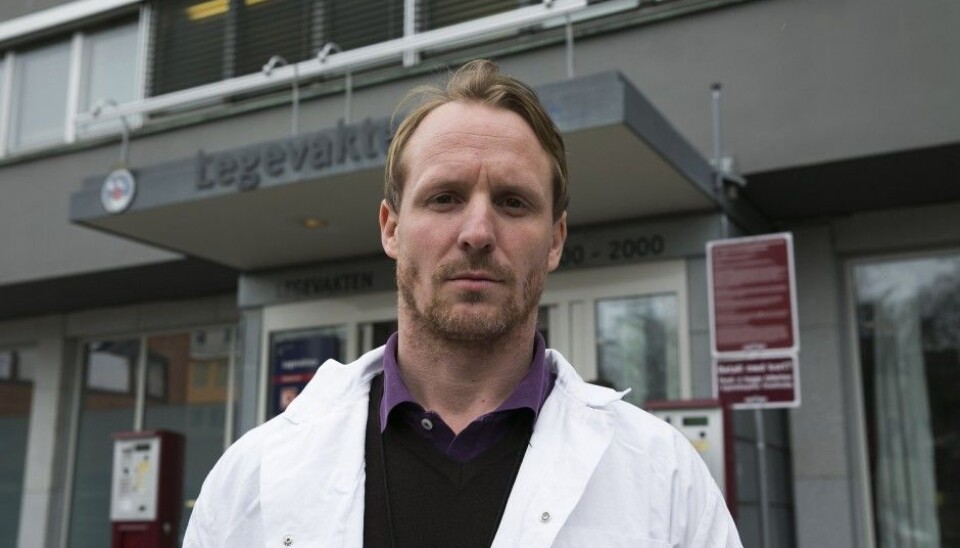
Stopping violence at emergency wards
Doctors and nurses should be conscious of how they behave towards patients to avoid being attacked. Some patients at the emergency ward make threats or act violently if they feel insulted.
One in three employees working in Oslo’s municipal emergency primary care centres has experienced violence from patients or relatives. The newspaper Dagsavisen reports the information, released by the National Centre for Emergency Primary Health Care.
Substance abuse and mental problems raise the risk of violence, say the researchers in the study.
But what triggers such reactions against people who are trying to help?
The interplay between health personnel and patients/patient relatives at the emergency primary care centres plays a huge part, according to employees who were interviewed about their experiences.
Patients can get angry when they feel they are not being taken seriously.
Don’t want to be touched
Many health staff display their compassion for the patients in part through physical contact. But touching a patient can be counterproductive.
“I entered the room from a door behind (the patient). Then I put my arm around her like this (demonstrates) and said ‘you will soon receive help’. That was a stupid thing to do. It triggered something in her. The little girl – she jumped up and tried to strangule me while she pushed me up and towards the wall,” said a nurse to researchers at the National Centre for Emergency Primary Health Care, which is located at Uni Research Health in Bergen.
The researchers interviewed 37 doctors and nurses at emergency wards about their experiences of violence at work.
Hitting and kicking
Doctors and nurses will often have no clue of the backgrounds that burden patients at the emergency ward. The patients might feel being touched as an invasion that wakens old traumas.
Touching might not be painless, either. Chief Physician Fredrik Rønning Iversen recognises this from daily work at the Oslo Emergency Ward.
He has been attacked when waking an unconscious overdose patient.
“I was punched and kicked. When patients wake up, being touched can be unpleasant and they can get violent,” he says.
“I know this has also happened to others.”
Fight for recognition
The employees who were interviewed said that patients can sometimes get aggressive when they can’t get what they think they need.
“For instance, we have patients who want medications that are addictive. If we say we cannot prescribe them, they can get discontent and angry,” confirms Iversen.
But violence can even be experienced when resourceful parents come in with children who only have fevers from colds. There can be other children in the ward who need more immediate attention but these parents get frustrated when they have to wait a long time for help.
The chances of violence and threats rise when constraints are imposed, like when a patient is brought in for an examination by concerned relatives or the police. The patient has then lost control of his or her own personal space, or body.
“The aggression can be understood as a result of the patient’s struggle for recognition,” says researcher Tone Morken on the web pages of Uni Research.
Health personnel responsible
The researchers infer that health personnel shoulder the main responsibility for creating the right atmosphere. The interaction is out of balance because the doctor has something the patient needs.
Showing recognition requires taking the patient seriously, listening and understanding. Tone Morken explains that doctors and nurses need to be conscious about the way they communicate and handle patients in this context.
Dr Fredrik Rønning Iversen concurs. The doctors can do a lot to calm down a situation before it might escalate.
“I think we have a responsibility to do what we can in the situation to prevent it from getting violent. We have to learn to identify situations where an aggressive atmosphere could arise and take precautions as early as possible,” he says.
“If we can’t meet their needs we have to explain it in as professional and proper way was possible.”
No, not to blame
But Iversen disagrees that health personnel have the main responsibility for preventing aggressive behaviour from patients.
“Health personnel should not be necessarily given the main blame if the patient is violent or makes threats. We can’t always prevent this though proper communication. Some are aggressive when they come in."
Researcher Tone Morken makes several suggestions about how health personnel can prevent violent situations. She thinks doctors and nurses need to learn how to be aware of the way they come across to patients.
“This can be done, for instance, by emergency ward personnel discussing relevant events and how they can help belay aggression. One can also train for such situations through role play,” she says to Uni Research.
Role play exercises
The point of departure for the study was in group interviews conducted in 2012-2013. The researchers have previously published an article based on the same interviews.
Last year the researchers presented four moves to help make emergency care facilities safer:
• Be prepared for threatening, violent situations. Read the danger signals and have a plan
• Resolve the mismatch between expectations and the service offered. Have consistent routines and maintain clarity about the emergency ward’s role
• Ensure supportive responses from management
• Minimise the risk of working alone
The last piece of advice to the researchers is hard to follow. Norway is a large country with a geographically spread, small population. Two out of three Norwegian emergency primary care centres have only one employee on the job at certain hours of the day, according to an earlier study by the researchers.
Everyday life
There are many employees on the job at Oslo Emergency Ward. It has recently started a course in which the entire staff is required to participate. They learn to recognise threatening situations and how to respond and behave.
The management follows up situations that get reported. But the employees do not report every threat or physical attack.
“They think this is just a part of their daily work,” says Chief Physician Fredrik Rønning Iversen.
The Oslo Emergency Ward is now charting such disturbances more systematically. Iversen hopes this will help make his work place cognizant of when employees are subjected to threats and violence.
--------------------------------------
Read the Norwegian version of this article at forskning.no
Translated by: Glenn Ostling
































